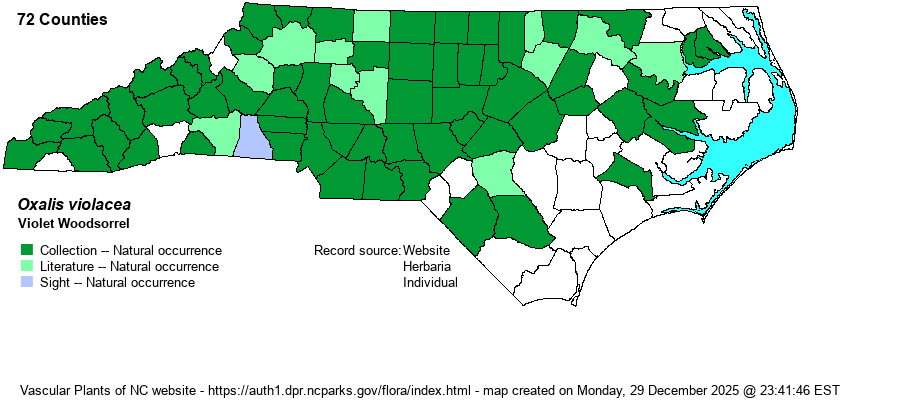| Author | L. | |
| Distribution | Essentially throughout the Mountains and Piedmont; in the Coastal Plain found scattered over the western and central portions, but absent near the coast.
This is a widespread Eastern and Central species, ranging from MA and ND south to northern FL and central TX.
| |
| Abundance | Common in most of the Piedmont; fairly common to frequent in the southern half of the Mountains, but infrequent to uncommon in the northern Mountains. Fairly common to frequent in the northern Coastal Plain, but rare to infrequent farther south; seemingly absent toward the coast. | |
| Habitat | This is a forest-based woodsorrel, being found in a wide array of forest types. It is most often found in mesic to rich hardwood or mixed forests, but it also occurs in bottomland forests, and into somewhat dry upland forests as well. |
| Phenology | Blooms from mid-February to May, and rarely into the fall; fruits soon after flowering. | |
| Identification | This is the only native rose-purple-flowered Oxalis, being confusable only with the exotic O. auriculata. This is a colonial species, often in fairly dense patches. The stem/leaves grow to only about 3-4 inches tall, with the flowering stalks extending above the leaves to 6-8 inches high. As with other Oxalis species, the leaves are clover-like, with 3 leaflets on long petioles. The flowers have 5 rose-purple petals, and a flower spread of about 1-inch across. When not in bloom, the species could be confused with a few yellow-flowered species, though the leaves of O. violacea are often (but not always) purple on the dorsal surface. This species has smooth flowering stalks, whereas the exotic species (O. articulata) has pubescent stalks. The exotic species also has sepals strongly pubescent as opposed to essentially glabrous in O. violacea. O. articulata, as expected of an exotic species, is the one commonly seen in gardens, lawns, and along roadsides, almost always in full sun. | |
| Taxonomic Comments | None. Note that O. articulata has often been named as O. rubra, such as in RAB (1968).
| |
| Other Common Name(s) | Wild Shamrock | |
| State Rank | S4 [S5] | |
| Global Rank | G5 | |
| State Status | | |
| US Status | | |
| USACE-agcp | | |
| USACE-emp | | |

